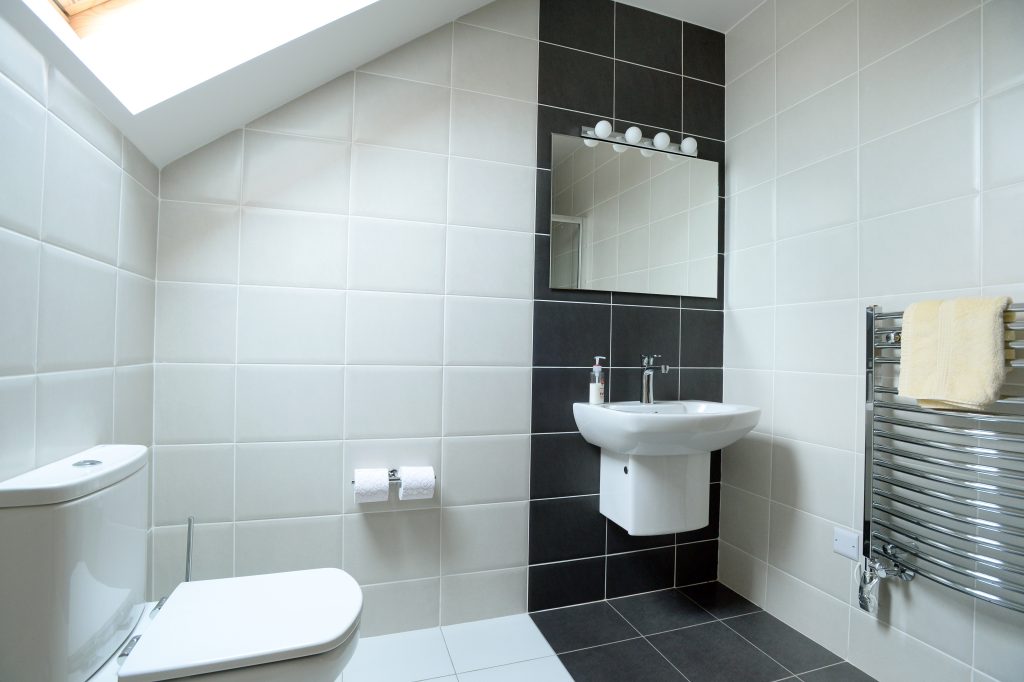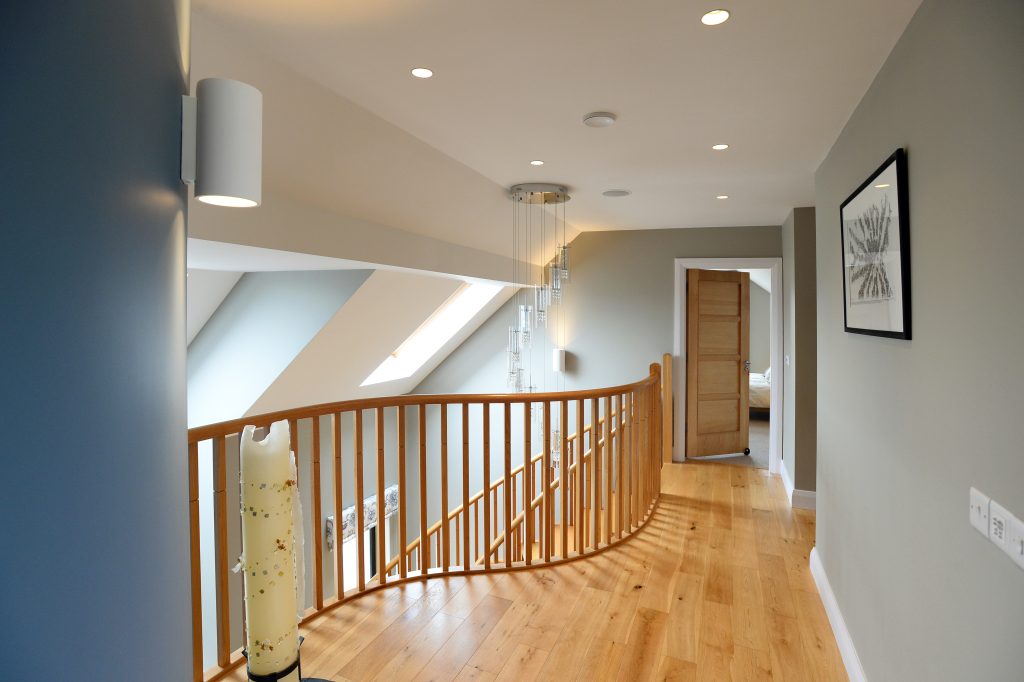How Fiona and Cormac Mitchell’s dream self-build in Co Cork turned into a nightmare. The good news is, there’s a happy ending.
In this article we cover:
- Their experience self-building in the 1970s compared to the experience of hiring a main contractor for this build
- Design stages and putting the project out to tender
- Choosing the builder and work they did to vet their credentials
- Early warning signs there might be issues with the builder
- Details of overcharging early on
- Issues with the driveway and being unable to resolve them
- Details of what went wrong with the build and getting to roof level
- Details of mediation proceedings
- How they remedied the defects
- The financial toll and impact on their mental health
- Full supplier list of tradespeople who repaired the defects
- How to spot early warning signs and protect yourself from a similar situation
Overview
House size: 370 sqm
Garage size: 190 sqm
Site size: 0.45 hectares
Ground floor: 150mm PIR insulation, 150mm concrete and 75mm screed.
First floor: Precast slab with 75mm screed.
Walls: Outer leaf 100mm concrete block, 150mm platinum bonded bead and 100mm concrete block inner leaf.
Roof: In situ cut roof with Spanish natural slates, 50mm x 25mm.
Windows: Black double glazed uPVC; aluclad double glazed patio doors
BER from spec: A3
Walking into Fiona and Cormac’s home you’d be forgiven for thinking it was the result of an exemplary self-build. It’s well designed, well built and offers wonderful views. It’s made to live and entertain in. But the road to get there was arduous, literally and figuratively.
Fiona explains: “A mix of very poor management, absenteeism and numerous mistakes that had to be fixed, resulted in our 12 month contract being dragged out over three and a half years. We moved into an unfinished home, with many second fix elements and serious snagging issues left for us to resolve, including a dangerously steep driveway.”
[adrotate banner="57"]“The irony is that we specifically chose a turnkey contract because we didn’t want to spend years completing the build. As we were very busy with work, we thought it’d be the quickest and least stressful way.”
“I had intended to write a book comparing the two experiences, of building our first house by direct labour and of doing things differently and more easily – or so I thought – with a main contractor.”
Context
“When we decided to self-build, both Cormac and I were established in our careers, we had grandchildren, friends, colleagues and family we wanted to see more of and be able to invite and stay,” says Fiona.
“We wanted a larger kitchen, a more open plan home incorporating the garden and yearned to live in a two storey again, like our first two family homes.”
“We self-built our third house, a four bedroom, split level bungalow with double garage. This was in 1979, we were in our twenties with two small children. Even though it was hard work, it was exciting,” Fiona fondly remembers.
“We had designed the house ourselves with advice from Cormac’s brother, a civil engineer and a relative who had experience in self-building. While the direct labour route was stressful, as project managers if we made a mistake, being in control meant we could recover and keep on track.
Warning signs
“We got planning permission and during the tendering process two main contractors contributed ideas to converting the plans into construction drawings.”
“We chose the company we felt had the best quality finish, which was achieved by a team of subcontractors who we were assured would also work on our build. ”

“We made enquires about the company, visited several of their builds and even met people who had run into problems with them but what they described didn’t match our experience so we dismissed concerns.”
“We read Selfbuild magazine to get up to speed with the current state of technology and other publications for interior design.”
“We were excited about all the new technology introduced since 1979 and wanted to know as much as we could about the new systems. One of the directors of the building company enjoyed explaining the benefits of extra insulation, airtightness packages, heat recovery ventilation and underfloor geothermal heating. We got along really well.”
Fiona says they were over the moon signing the contract in their solicitor’s office in the summer of 2010. “Our solicitor dampened my enthusiasm by saying he hoped we’d still be as ecstatic at the end of the build; I brushed off his comments but was perplexed by them.”
Maybe his comment was because the first warning sign came at this early stage. “Our solicitor advised that we use a standard legal contract, which he said would protect us more than the contract the builders had drawn up.”
“We wanted to start the project on a positive note, and we were in an atmosphere of trust.”
“Now I’m not sure whether signing a different contract would have changed anything considering that the legal system does not seem to be able to protect self-builders when they come up against issues with their contractor.”
Fiona says the contractor advised them in writing that they would only need an engineer to sign off on the stages and to draw up the snag list and that they would take on all architectural and engineering services at no extra charge, including plans for all of the systems to be handed over at completion.
“They said this would ensure a seamless build progression which they preferred.” “Alarm bells should have rung but didn’t, they should have rung again at the first stage payment,” continues Fiona. “We were invoiced for €9,000 more than the contract indicated for the foundation complete stage – there had been a price per row above ground level in the contract, but the builders justified the extra cost by saying the original contract calculations hadn’t been correct.”
“The contractor refused to progress if we didn’t pay the excess; our solicitor insisted this wasn’t in the contract and we were not liable. But because we wanted to maintain good relations he reluctantly advised we pay the excess as an ex gratia payment on condition that nothing like this happen again.”
“This was at the foundations stage when the driveway route and fill should also have been in place, but we had only a temporary drive yet we paid in full for that stage in good faith.”

No way driveway
“It was agreed that the contractor’s best option route including drawings be included in the contract. There’s a 12 metre difference between where the driveway starts and the finished floor level (FFL) of the house; it required a lot of fill.”
“Our self-build next door presented similar site conditions so we knew how important it was to get the gradient right,” adds Fiona.
“We also knew how important it was to start the project with the driveway foundation; the fill needs to be bedded down and machinery from site works is ideal to do this.” “The day the site was opened the contractors asked if they could put in a temporary access which didn’t follow the contract driveway route and arrived at the back of the site several meters below the FFL.”
“We agreed as they told us this was to facilitate deliveries for foundations only.” “Throughout the project the contractor refused to build the contract driveway and towards the end we felt compelled to accept the temporary route as permanent, the contractor agreed on a new set of drawings that the gradient would be 1 : 7 or better, but this gradient was never delivered.”
“We were left with a compromise driveway gradient of 1 : 3.9 and had major safety concerns; at that steep an incline all you can see going up is the bonnet of your car and going down you feel like you’re falling off a cliff!” “Shortly before the builders withdrew from site a tradesman’s car ended up hanging perilously over an unprotected three metre drop into the adjoining field, this confirmed to us just how dangerous the driveway was.”
“Unfortunately it was also partly constructed outside our site boundary. We are currently negotiating with the owner next door to buy the land as moving such a complex driveway would be extremely difficult and costly.”
The saga unfolds
“When we got to the blockwork, at the stage where the lintels for the windows and doors had been installed, I realised there was no space to fit curtain rails or blinds, and that the internal door heights seemed to have been built for giants,” recounts Fiona.
“When asked about this the blocklayers, who were doing a fantastic job, said they were required to follow the plans given to them by the contractor.” “Several calls to the contractor who was overseeing our build were made before he visited the site.
He later sent an email saying that there was an error in transferring drawings across computer packages and all walls would have to be knocked to sill and lintel level.” “They said that these things happen and it was their problem to deal with.”
“We discovered after the contractors had withdrawn from site without completing the build that they had built the foundations 700mm too high.”
“This was actually apparent when we got to the roof ridge, we were very disappointed to find that the dormer part was lower than on the plans and we had to lose floor area to facilitate the roof slope staying compliant with what we got planning permission for.”
This discrepancy at foundation level had many knock on effects, including the addition of seven steps to their front door and the need for fall protection barriers. “As we didn’t know at the time what had caused these issues we didn’t realise the price of their mistakes were being passed on to us as extra costs.”
And then they got to the roof
“We were weeks behind schedule when felting was done just before Christmas 2010. It was a cold winter and snow remained on the membrane for at least three weeks.”
“The roofers returned in January to put up the natural slates; as we later found out the felt wasn’t up to standard and I noticed tears in the membrane. I contacted the builder to arrange for a site visit but it wasn’t until 8,000 slates on the house and 5,000 on the garage had been installed that the builder came to have a look,” continues Fiona.
“Their hope was that they wouldn’t be judged by the problem but by their approach to fixing it, and we really bought into that. They asked for our engineer to do up the plans for how the stripping was to be done.”
“The aim was to reinstate the roof in five weeks. The first step was to remove all the slates, battens, damaged felt from both buildings, the lead valleys and 13 roof lights. All other work on site was on hold.”
“The slates were replaced as the quarry wouldn’t stand over the product otherwise. An agreement was made between the builder and the supplier to take back the damaged ones, allowing an amount against them on the new order. In the end it took four months to complete the roof.”
“This was a turning point; the builder refused to return on site until we contributed to half of the slates’ cost and we agreed to a number of conditions including advanced payments.”

Inching towards the finish line
“We just wanted to get our house finished and were desperate to speed things up. We agreed to employ an additional engineer and project manager to smooth the way to the following Christmas; the new finish date.” “But this date came and went with very little progress.
Our project manager declined to renew his contract as the contractor was not cooperating in the process. Tradesmen were sympathetic and as shocked as us about the situation saying they had to go where they were sent.”
“At all times we maintained a good working relationship with our contractor, there was always a degree of light hearted banter and good humour,” adds Fiona.
“Part of the build agreement was to have regular updates, both weekly and monthly. But the schedules kept being pushed back, and the updates eventually stopped after the roof problems arose.
Attendance on site became erratic with long periods of non attendance.” “It came to a stage where we were asked to choose finishes, paint colours and tiles for bathrooms and floors. It was so exciting to work with a great interior designer and get this right.”
“But my excitement soon turned to horror as we watched the first painters employed do no preparation, painting walls over mould and grit with colours we had not picked.
They failed to cover windows, pre finished wooden floors and doors, stairs, oak window boards. All of these were splattered with paint.” “It was so bad the builders paid for a company to clean up the paint and restore the floors and doors; they also got an excellent replacement painter in afterwards”. The situation was rapidly souring and exchanges became less pleasant with the builder.
Financial distress
“While the contractors took on many new projects in this third year of our build they seemed unwilling to finish our house. They seemed to be pushing us to terminate the contract but our solicitor advised us against this; he had seen too many clients locked out of their boarded up houses.
He advised us to keep moving the project towards the finish line, this was really sound advice.” “Our mortgage lender was worried about the slow progress and insisted on full house insurance. This required that the house be occupied. The second fix stage had been ongoing on for 18 months; in March 2013 a guaranteed move-in date of May 2013 was agreed with our solicitor. House insurance and a furniture removal firm were booked.
It was the coming together of these pressures that resulted in us gaining possession of the house on that date, the contract had not been completed and we were never given all the keys.”
The last direct dealing with the builder was when they showed up on site with machinery to finally do the driveway and remaining groundworks. “Throughout the build all our stage payments were paid on time and many payments were paid in advance.
Only Build Completion Stage and Retention were pending. A sum was also being held by our solicitor until the driveway, the remaining second fix items and the snag list were completed. “Our solicitor had stipulated that no further payments be made until all works were completed, because according to our accounts we had already overpaid by tens of thousands.”

“The builder asked for the sum being held by the solicitor be released. He said they could do nothing until we paid them that amount,” continues Fiona. “We desperately wanted to be finished with the build so … with our solicitor on leave that day and Cormac off I very unwisely caved in to getting the money released.”
“After picking up the cheque they did a small amount of work over a few days; then they stopped. A week or so later a machine operator arrived and without notice drove the remaining machinery off site.”
“Weeks passed before we got a letter saying they had withdrawn from the project. I took this very personally and felt really betrayed, but also relieved they were gone, we thought at least the continuous pressure and stress might stop.”
“But the negotiations dragged on, with the contractor claiming we owed them huge sums of money. Not knowing what was going to happen next was really stressful.”
“We filed for arbitration as was stipulated in the contract but they asked for mediation. We agreed, and were required to pay half the €6,950 mediation fee up front; we also had our solicitor, engineer and QS to pay for their attendance.”
“We thought this would give us some closure but the process failed and we filed again for arbitration but the contractors refused; a few months later they liquidated the company’.”
Clouds and silver linings
Fiona and Cormac were fortunate that they were able to shoulder the financial strain this experience has put them under. However the toll on their health was in many ways more worrying; they both became very ill and an additional knock on effect was of Fiona having to take early retirement on health grounds from a career she loved.
“When the contractors left we gradually began to recover, finding many of the symptoms had been due to chronic stress. One of our best decisions was to finish our landscaping,” adds Fiona. “The first year living in the house was tinged with regret, I think I was still struggling with feelings of betrayal.”
Small reminders in their every day didn’t help as endless work remains to be done to make the driveway safer, even though barriers have been installed to lessen the likelihood of accidents. And yet, they’ve managed to move on. “This debacle took six years out of our lives, it’s not taking any more,” says Fiona.
“Looking around our home we see the magnificent work the subcontractors and tradesmen brought to the build. The electricians, plumbers, tilers, the second painting company and others. Every corner is perfectly plumb, the curved walls beautifully executed, the plastering admired by everyone, our lighting plan one of our best decisions, and a kitchen well designed and a joy to bake, cook and entertain in, the amazing curved stairs the centrepiece of our hall.”
“This house feels like home now and the memories of the trauma and stress of the build are being replaced by joyful occasions; our daughter’s and our son’s wedding celebrations last year, having our grandchildren here to stay for holidays and watching them explore the garden.”
“The awful nightmare was really difficult to live through but it is over now and the dream has come true; this house is a great place to be and will continue to be at the centre of great gatherings and intimate times to come.” Maybe it is time she tackled that book…
Fiona and Cormac’s harrowing experience is in many ways a product of the recession, and while the story did end with a really lovely house built to the highest standards, it also provides the opportunity to share some advice with prospective self-builders, including making sure you have a system of checks and balances in place. This automatically happens when you lead the project but can be more difficult to achieve in a contractor-led scenario. “We had all of our eggs in the same basket, having the builder act as architect, engineer, builder and project manager,” explains Fiona. “This was a bit like the spider legislating for the fly but we trusted our builder totally.”
Even if you have a great relationship with your builder, it’s a good idea to have your own quantity surveyor and designer accompany you throughout the project to identify any possible issues along the way. Insisting on this shouldn’t impact on your relationship with any of the parties and if it does, that should ring the alarm bells. To fully protect yourself, Fiona believes it’s best to have penalty clauses linking the contract to each stage and release only the corresponding money (no exceptions) when each stage has been completed. If they genuinely need it for materials that indicates their cash flow is probably in trouble. “We should have listened to our solicitor’s advice on everything, including withholding payments and not making payments that we were not liable for. Arbitration and legal recourse are best avoided,” she adds, “as they’re expensive and are unlikely to have a positive outcome.”
Planning drawings: Jacqueline Manley MIEI, Civil, Structural, Architectural, Planning. Email: jmanley@eircom.net
BER and air pressure test: Collins Energy Consultants, Charleville, Co Cork, www.collinsenergy.ie
Block Layer: Eamon Fuller, email eamonjfuller@gmail.com
Plasterer: McAuliffe Bros
Electrician: A & J O Callaghan Electrical, Buttevant, Co Cork, email jasonocallaghan48@gmail.com
Plumber and installer for underfloor heating: Kevin O’ Donoghue & Co
External windows and doors: Munster Joinery, Ballydesmond, Co Cork, www.munsterjoinery.ie
Internal doors, handles and hinges: Ryans Doors & Floors, Cork, www.ryansdoorsandfloors.com
Kitchen, utility and Neff electrical appliances: Celtic Interiors, Douglas, Cork, www.celticinteriors.com
Ground source heat pump: Alternative Heating & Cooling Ltd., Skibbereen, Co Cork, www.ahac.ie
Heat recovery ventilation: Proair from Munster HRV, Cashel, Co Tipperary, www.munsterhrv.com
Central vacuum system: Cyclovac Ireland, Dungarvan, Co Waterford, www.cyclovac.ie
Lighting plan: David Cahill, Lighting and Living, email info@davidcahill.net
Light fittings and sockets: Lightplan Electrical Distributors, Cork, www.lightplan.ie
Colour consultant and interior designer (painting / bathroom tiling): Barbara Hanan, Crosshaven, Co Cork, email barbarahanan@gmail.com
Curtains and blinds: Catherine Troy Interior Design, Midleton, Co Cork, www.catherinetroydesign.ie
Stoves: Cork Stoves & Gas Fires, Cork, www.corkstoves.ie
Exterior glass rail: Cork Glass Centre, Cork, www.corkglass.ie
Fireplaces, kitchen island, worktops and ensuite bathroom shelves: Elm Marble & Granite, Foynes, Co Limerick, www.elmfireplaces.com
Wastewater treatment plant: W&M Kiely Ltd., Blarney, Co Cork, www.wmkiely.ie
Patio slabs: Kilwaughter Cork Ltd., Ovens, Co Cork. www.kilwaughter.com
Roof slates: Killoran Slate, Nenagh, Co Tipperary, www.killoranslate.ie
Tiles and timber floors: JMR Centre Ltd., Mallow, Co Cork, www.jmrcentre.ie
Bathroom fittings: MD O’ Shea, Ballincollig, Co Cork, www.mdoshea.ie,and Irish International Trading Corporation, Cork
Internal and external painting (second contractor): Apex Painting Ltd., Clonheen, Co Cork, eugene@apexpainting.ie
Driveway surface and drainage: RCM Tarmacadam Ltd, Enniskeane, Co Cork, mobile JJ McCarthy
Garden design: Planting design and Stonework Dominick Cullinane, Glounthaune, Co Cork, www.dcgardendesigns.ie
Stone mason: Ger Harrington

































3 Comments